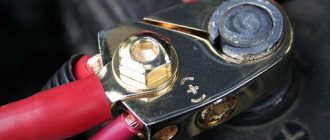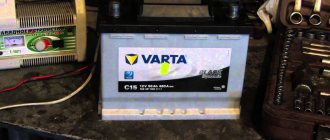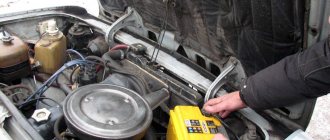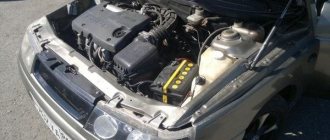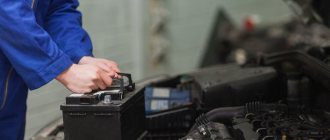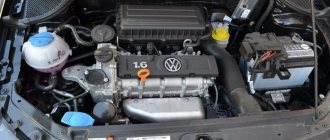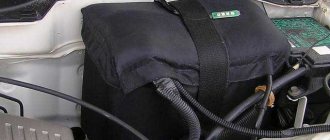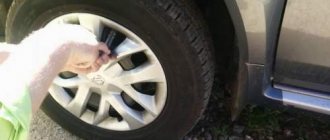Causes of broken or loose terminals
- Frequent removal of the battery or “throwing away” terminals. To connect the battery to the car, terminals made of soft metals such as lead, copper, aluminum, and brass are used. Due to frequent removal and installation, their clamping force disappears, and in some cases the terminal is completely destroyed
- Too much effort
when tightening. Despite the fact that the metal is soft, when tightening too much force, the terminals can crack or break off - High heat. If there is poor contact or problems with the wiring, the terminals may become hot, causing them to become deformed.
Preparing to remove the battery
The need to remove and install the battery may arise for several reasons: replacement with a new battery, the need for charging, installation of new electrical equipment, repair of components that are difficult to access if the battery is installed. When replacing an old battery with a new one, you need to pay attention to the location of the terminals. It differs for different types of machines. You should choose a new battery with the same pole arrangement as the old one, otherwise the wires may not reach the terminals.
Before starting work, you should prepare the following tools:
- open-end wrench 10 mm;
- 12 or 13 mm socket wrench with collar (depending on the car model);
- protective glasses;
- latex gloves;
- baking soda solution.
Before removing, you need to carefully inspect the battery for broken seals, cracks or stains on the surface. The electrolyte, which is located in the battery, contains a solution of sulfuric acid and causes burns if it comes into contact with the skin.
When working with damaged batteries, you need to wear rubber gloves, and if the skin is damaged, neutralize the acid with a solution of baking soda.
Consequences
Poor contact at the battery terminals leads to a decrease in the efficiency of all electrical systems of the car.
The most common problem is rapid battery drain.
when parked for a long time. At some point, the car may simply not start. Poor contact is also associated with poor operation of the starter when starting.
Oxidation of contact pair
. The formation of a white coating on the terminals and electrodes of the battery is the consequences of oxidation, which occurs from poor contact. As a result, problems arise with charging the battery while driving and its rapid discharge when parked.
Increased load on high-voltage wires
. This can lead to the wire burning out or a fire (many people cover the engine with flammable fabrics in winter).
Damage to vehicle electrical equipment
. When starting the engine, voltage surges occur, which negatively affect the devices and can damage them.
Battery care
Proper care and operation will extend the life of the battery.
To maintain the battery, you need to wipe its case with a dry, clean cloth to remove moisture and remove dirt and dust from the ventilation holes. If the battery is serviceable, then regularly measure the electrolyte level and its density. Monitor the condition of the contacts, clean the terminals and treat them with a special anti-corrosion compound. The installation sequence is very important when installing a battery. The main thing is to remember that you must connect the plus first, and then the minus. If everything is done correctly and the on-board computer is configured, then you can count on trouble-free operation of the car.
A car battery is needed to start the engine and operate electronic systems when the engine is turned off. It should be maintained in working condition - properly cleaned of deposited sodium carbonate elements, check the electrolyte level and charge if necessary. To carry out maintenance work, sell or replace the battery, it must be removed from the car. There are certain rules that indicate how to remove the battery from a car, and what precautions must be taken when doing so.
Selecting terminals when replacing
There are a large number of battery terminals available on the market. Before replacing the old terminal, you need to know how to select a new one.
The part must match the size of the electrodes on the battery, otherwise it will not fit or tighten. The size of the terminal should be such that when tightened tightly there is a margin of 3-5 mm.
It is also necessary to match the diameter of the hole for the high-voltage wire, which must be tightly secured in the terminal.
When choosing the material from which the terminal is made, preference is given to lead. It has good conductive properties, is soft enough for crimping and does not form a galvanic couple with the battery electrode. If you cannot find these, you can use brass or copper.
Those who use modified acoustic systems in their car, with a large number of components, should pay attention to the terminals that have additional places for attaching power wires.
There are also kits on sale that consist of a terminal with a pressed wire. This replacement option is preferable, but requires more effort.
If your car does not have a protective cover for the positive terminal, it is advisable to purchase it separately. It will protect the connection from foreign moisture, dust, as well as from accidental short circuit of the “plus” to ground.
An important role is played by the ability to quickly remove the terminals from the battery, since when carrying out repair work or a short circuit occurs in the electrical wiring, you need to turn off the power to the car.
Which terminal should be removed first?
Before you begin to replace the contacts for connecting to the battery, you need to perform several preparatory measures.
Some motorists make the mistake of choosing the wrong terminal when removing it, which should be removed first.
When replacing terminals or any other operation that involves removing battery contacts, the negative terminal is always disconnected first.
The sequence of preparation itself can be represented as follows:
- turn off the ignition, remove the key from the lock;
- wait about 15 minutes, letting the car just stand;
- using keys or other tools, disconnect the negative terminal;
- only then disconnect the plus;
- fix the wires so that they do not touch the battery terminals;
- wipe the surface with a dry cloth;
- if there are traces of electrolyte on the case, use a solution of water and soda, wiping the battery with a rag soaked in it;
- if there is a bottom lock for installing the battery, unclip it;
- remove the battery from the engine compartment.
That's it, now you can start replacing.
Replacement
For replacement, we suggest you watch this video:
Before carrying out work, you must turn off the ignition and disconnect the battery. Most drivers know which terminal is removed first, but do not always follow this sequence. Breaking the order is important from a security point of view. If the “plus” is accidentally shorted to ground, the electronics and electrics of the car can be damaged, so first of all, the negative terminal is removed from the battery, and then the positive one.
Next, you need to remove or loosen (depending on the design) the battery mount and remove it from the “shelf”. It is strictly not recommended to replace the terminals with the battery installed!
Next, you need to disconnect the terminals from the high-voltage wires. If they are secured with a bolt clamp, then you need to loosen the tension and remove the wires. If the wires are crimped by the terminal body, use tools to loosen or completely unbend the clamp and pull out the wire.
If you cannot free the wires from the terminals, you can cut each of them and measure the length, since after cutting they may not be enough to reach the battery electrodes.
After dismantling the old terminals, you need to check the integrity of the wire insulation, and then install new ones.
The battery is connected in the reverse order - first the positive terminal, then the negative one. Before connecting, if necessary, clean the electrodes on the battery.
How to remove the battery from a car
Before removing the battery from the car, novice car enthusiasts think disdainfully - business as usual, unscrew a couple of nuts and remove the battery. But in practice, this approach leads to sad consequences: either something burns out, or, even worse, the wiring shorts out, and here you cannot do without the help of a specialist.
So remember!
Removing the battery from the vehicle must be carried out in compliance with strict safety precautions!
In addition to its main purpose - providing electricity for the starter, the battery powers other electricity consumers, many of them non-switched. And if the headlights and interior lighting have their own switches, they are usually in the off state, and an increase in voltage does not affect them, then the discrepancy between the power supply current parameters and the declared value will affect the electronic filling and especially the car’s on-board computer.
Before removing the battery from the car, do a couple of simple checks and preparations. This procedure will be completely safe for your car.
Tool preparation
Before the process of removing the battery from the car, you need to prepare a tool. First of all, you will need 10- or 12-gauge spanners - these are the most common nuts used on battery terminals.
Note that in some modern cars, especially premium ones, the battery is located not in the engine compartment, but under the driver’s seat (or in the trunk). To access it, in this case, you will have to partially dismantle the chair mount. To do this, you will need 8 mm and 13 mm keys (a 13 mm key for the seat “slides” in many cars, in particular in BMW cars).
Replacing the positive battery terminal
If there is a need to replace the positive terminal, select the desired terminal from the pair. The sequence for removing and installing the component is the same for both electrodes.
- Remove the contacts from the wire, then release the anode from the clamp placed on top.
- Clean the contact and prepare the wires for installation.
- First of all, connect the high-voltage cables from the on-board network and additional wires from the music center.
- Place the contact on the anode pin and secure it to it.
You might also find a practical guide on how to properly tighten terminals, video, useful
To connect the battery to the vehicle's on-board network, metal contact plates with threaded fasteners are used. During operation, the nodes become deformed, which impairs the transmission of electric current. Replacing the battery terminals allows you to restore the functionality of the circuits and reduces voltage losses.
Which terminal is removed first when replacing the battery?
To change the terminal, you need to disconnect the battery from the vehicle's on-board power supply (disconnection is made with the ignition off). On some cars equipped with airbags, when the power is disconnected, errors occur that are reset using the service computer.
If the car is equipped with a radio with protection, then the presence of the code is first checked (recorded in the service literature).
To disconnect the battery you will need a set of wrenches. The negative wire is disconnected first, which avoids a short circuit if the power source is handled carelessly. Then the battery mounting plate located on the lower edge of the case is unscrewed. After removing the power device, the car owner can begin to repair or replace the power wiring terminals.
On some cars, a metal element installed along the power source cover is used to secure the battery.

